Financial Strategy Analysis Report: JetBlue Airways Case Study
VerifiedAdded on 2020/04/29
|18
|4387
|57
Report
AI Summary
This report analyzes the financial strategy of JetBlue Airways Corporation, focusing on its investment plans and funding options for aircraft acquisitions. The report begins with an executive summary outlining the company's goals and challenges, including the need for significant capital expenditure to support growth. It defines the problem JetBlue faces, including the need to finance aircraft purchases and other investments. The report then provides an industry analysis, comparing JetBlue's financial structure to that of other airlines, including both low-cost and traditional carriers. It explores financial alternatives available to JetBlue, such as equity issuance and convertible debentures, and conducts a financial statement analysis to evaluate the impact of these options. The analysis includes calculating the weighted average cost of capital (WACC) and assessing the optimal capital structure for minimizing WACC and maximizing shareholder value. The report concludes with recommendations for JetBlue's financial strategy, emphasizing the issuance of equity as the most feasible alternative for planned investments.
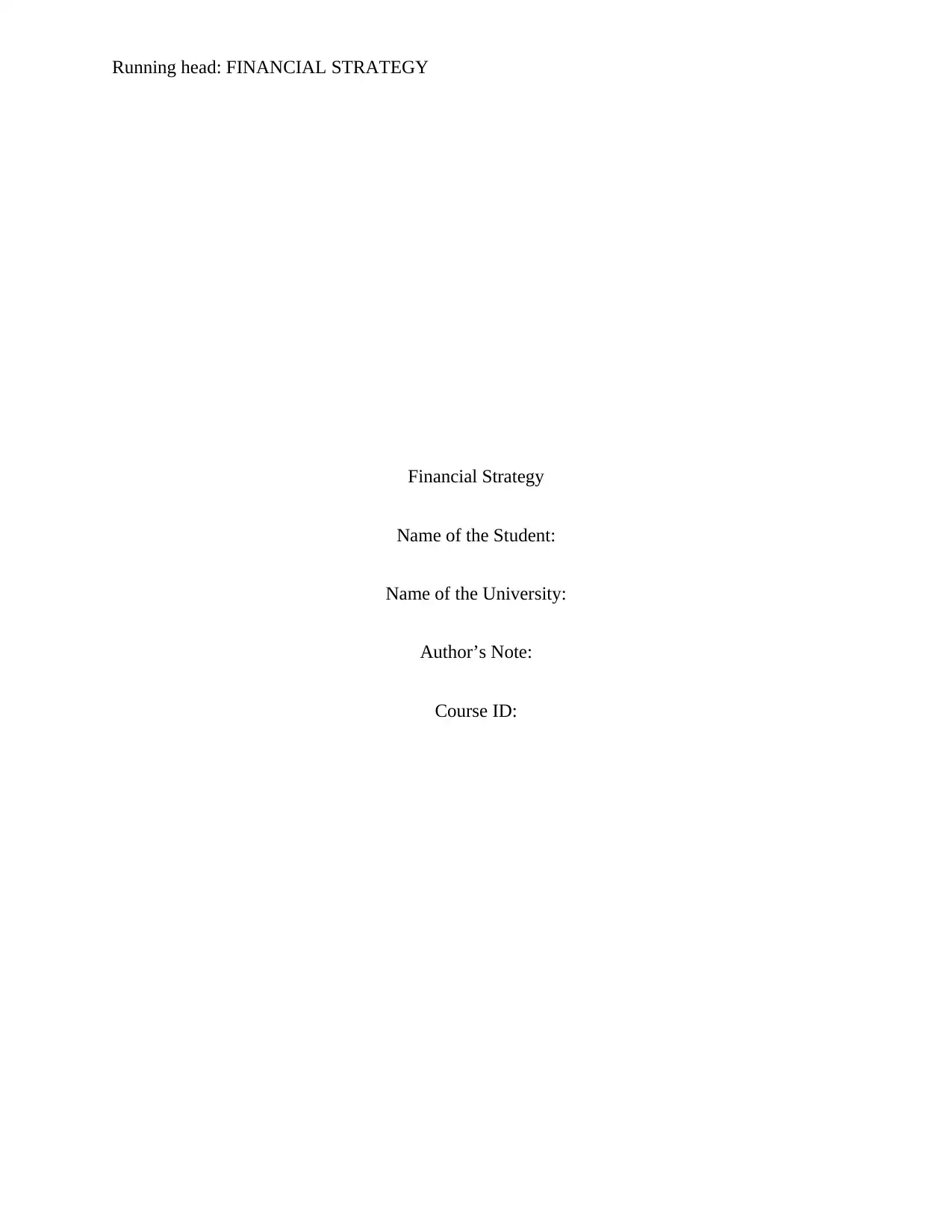
Running head: FINANCIAL STRATEGY
Financial Strategy
Name of the Student:
Name of the University:
Author’s Note:
Course ID:
Financial Strategy
Name of the Student:
Name of the University:
Author’s Note:
Course ID:
Paraphrase This Document
Need a fresh take? Get an instant paraphrase of this document with our AI Paraphraser
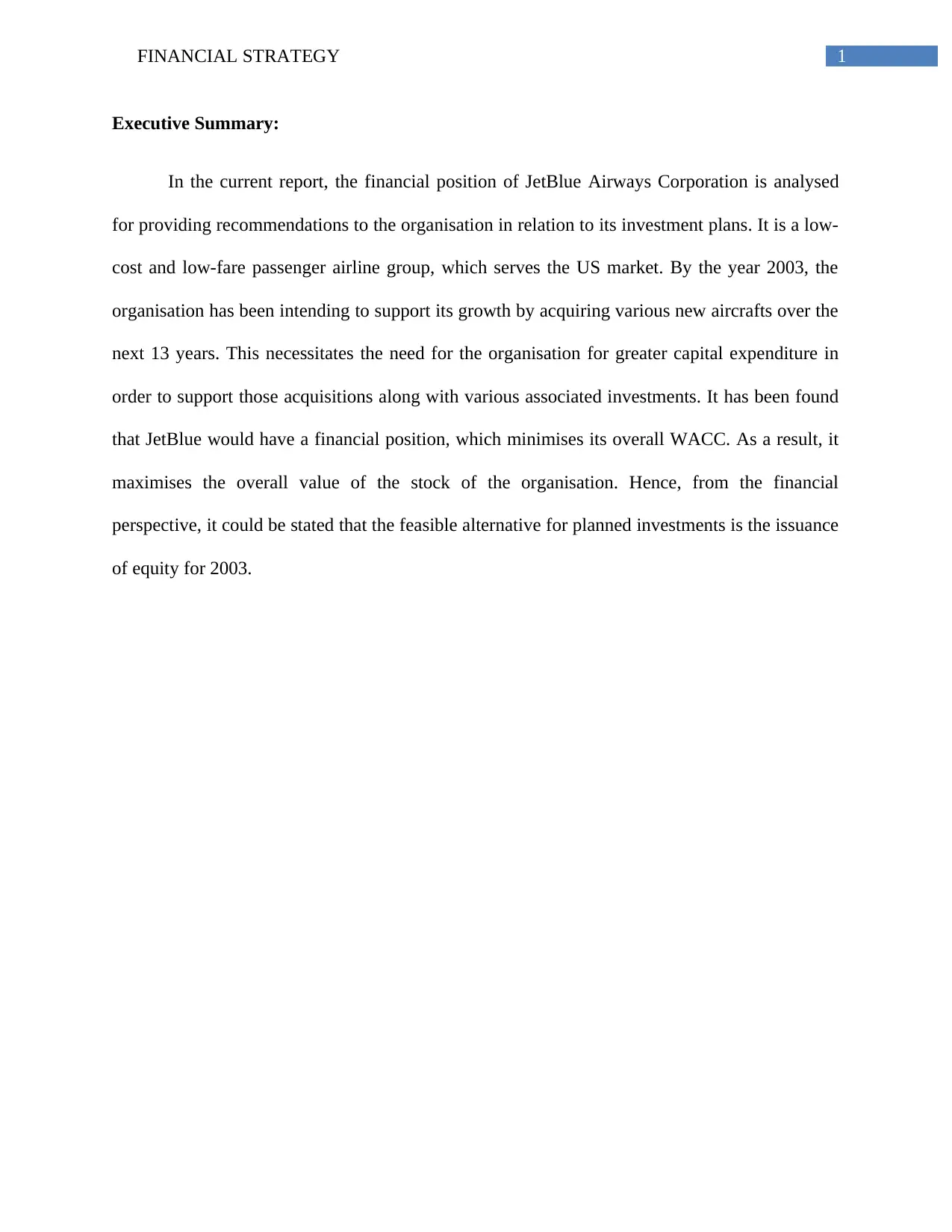
1FINANCIAL STRATEGY
Executive Summary:
In the current report, the financial position of JetBlue Airways Corporation is analysed
for providing recommendations to the organisation in relation to its investment plans. It is a low-
cost and low-fare passenger airline group, which serves the US market. By the year 2003, the
organisation has been intending to support its growth by acquiring various new aircrafts over the
next 13 years. This necessitates the need for the organisation for greater capital expenditure in
order to support those acquisitions along with various associated investments. It has been found
that JetBlue would have a financial position, which minimises its overall WACC. As a result, it
maximises the overall value of the stock of the organisation. Hence, from the financial
perspective, it could be stated that the feasible alternative for planned investments is the issuance
of equity for 2003.
Executive Summary:
In the current report, the financial position of JetBlue Airways Corporation is analysed
for providing recommendations to the organisation in relation to its investment plans. It is a low-
cost and low-fare passenger airline group, which serves the US market. By the year 2003, the
organisation has been intending to support its growth by acquiring various new aircrafts over the
next 13 years. This necessitates the need for the organisation for greater capital expenditure in
order to support those acquisitions along with various associated investments. It has been found
that JetBlue would have a financial position, which minimises its overall WACC. As a result, it
maximises the overall value of the stock of the organisation. Hence, from the financial
perspective, it could be stated that the feasible alternative for planned investments is the issuance
of equity for 2003.
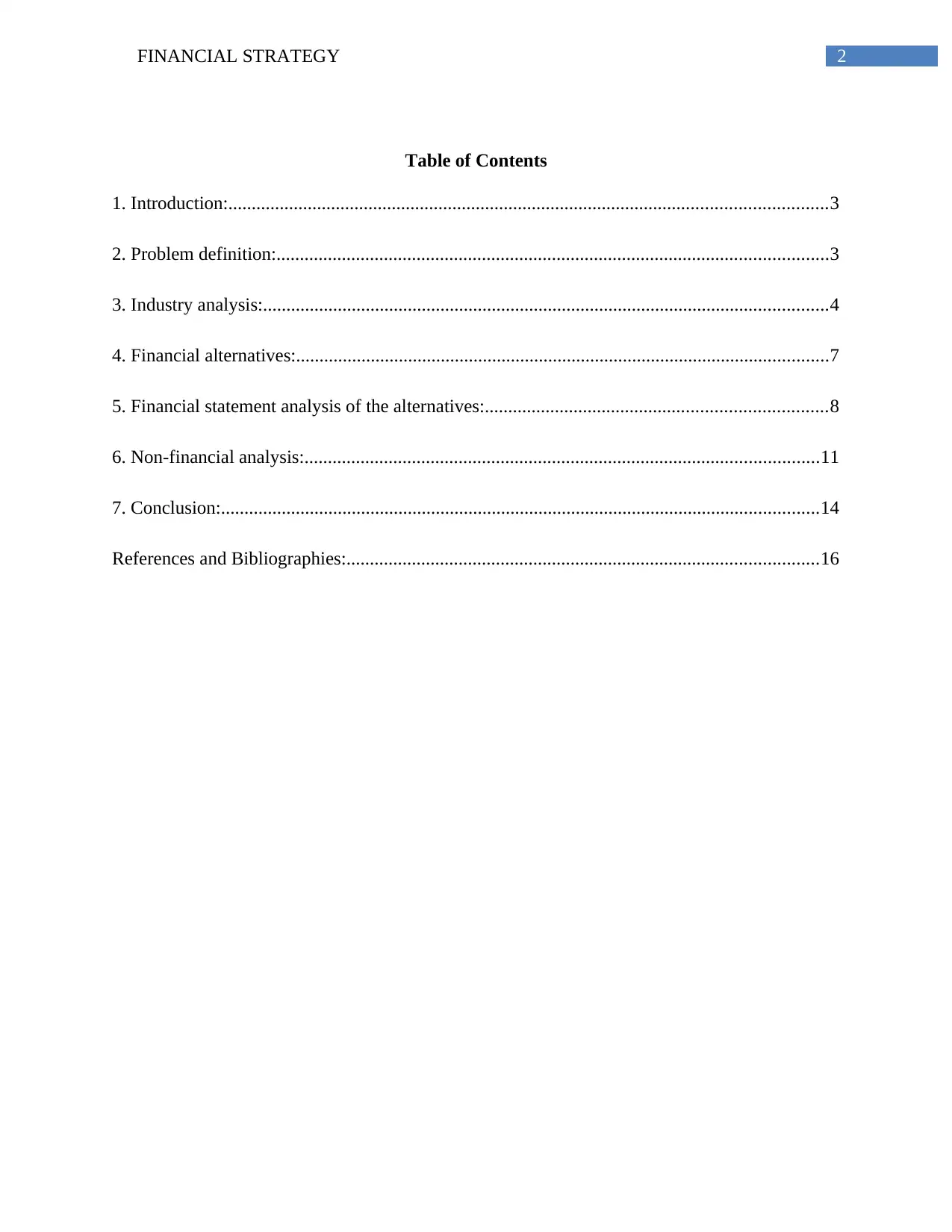
2FINANCIAL STRATEGY
Table of Contents
1. Introduction:................................................................................................................................3
2. Problem definition:......................................................................................................................3
3. Industry analysis:.........................................................................................................................4
4. Financial alternatives:..................................................................................................................7
5. Financial statement analysis of the alternatives:.........................................................................8
6. Non-financial analysis:..............................................................................................................11
7. Conclusion:................................................................................................................................14
References and Bibliographies:.....................................................................................................16
Table of Contents
1. Introduction:................................................................................................................................3
2. Problem definition:......................................................................................................................3
3. Industry analysis:.........................................................................................................................4
4. Financial alternatives:..................................................................................................................7
5. Financial statement analysis of the alternatives:.........................................................................8
6. Non-financial analysis:..............................................................................................................11
7. Conclusion:................................................................................................................................14
References and Bibliographies:.....................................................................................................16
⊘ This is a preview!⊘
Do you want full access?
Subscribe today to unlock all pages.

Trusted by 1+ million students worldwide

3FINANCIAL STRATEGY
1. Introduction:
In the current report, the financial position of JetBlue Airways Corporation is analysed
for providing recommendations to the organisation in relation to its investment plans. It is a low-
cost and low-fare passenger airline group, which serves the US market. By the year 2003, the
organisation has been intending to support its growth by acquiring various new aircrafts over the
next 13 years. This necessitates the need for the organisation for greater capital expenditure in
order to support those acquisitions along with various associated investments (Alamdari &
Fagan, 2005).
A background research is carried out for evaluating the ways the other airlines are
funding their aircraft acquisitions and other investments. The various alternatives of funding
available to the organisation are studied in association with the financial position of the same.
Finally, a non-financial evaluation of the debt and equity alternatives is conducted in relation to
all those business areas other than finance.
2. Problem definition:
According to the case study, JetBlue Airways Corporation has finished an initial public
offering (IPO) in 2002 around two years after its establishment. JetBlue has a successful business
model and effective financial outcomes during that timeframe and it has performed well in
contrast to the other US airline firms between 2000 and 2003 (Bhalla, 2004). By July 2003,
JetBlue has been experiencing various opportunities to grow by including new markets and new
flights to the current destinations. For achieving such growth, the organisation has been planning
1. Introduction:
In the current report, the financial position of JetBlue Airways Corporation is analysed
for providing recommendations to the organisation in relation to its investment plans. It is a low-
cost and low-fare passenger airline group, which serves the US market. By the year 2003, the
organisation has been intending to support its growth by acquiring various new aircrafts over the
next 13 years. This necessitates the need for the organisation for greater capital expenditure in
order to support those acquisitions along with various associated investments (Alamdari &
Fagan, 2005).
A background research is carried out for evaluating the ways the other airlines are
funding their aircraft acquisitions and other investments. The various alternatives of funding
available to the organisation are studied in association with the financial position of the same.
Finally, a non-financial evaluation of the debt and equity alternatives is conducted in relation to
all those business areas other than finance.
2. Problem definition:
According to the case study, JetBlue Airways Corporation has finished an initial public
offering (IPO) in 2002 around two years after its establishment. JetBlue has a successful business
model and effective financial outcomes during that timeframe and it has performed well in
contrast to the other US airline firms between 2000 and 2003 (Bhalla, 2004). By July 2003,
JetBlue has been experiencing various opportunities to grow by including new markets and new
flights to the current destinations. For achieving such growth, the organisation has been planning
Paraphrase This Document
Need a fresh take? Get an instant paraphrase of this document with our AI Paraphraser
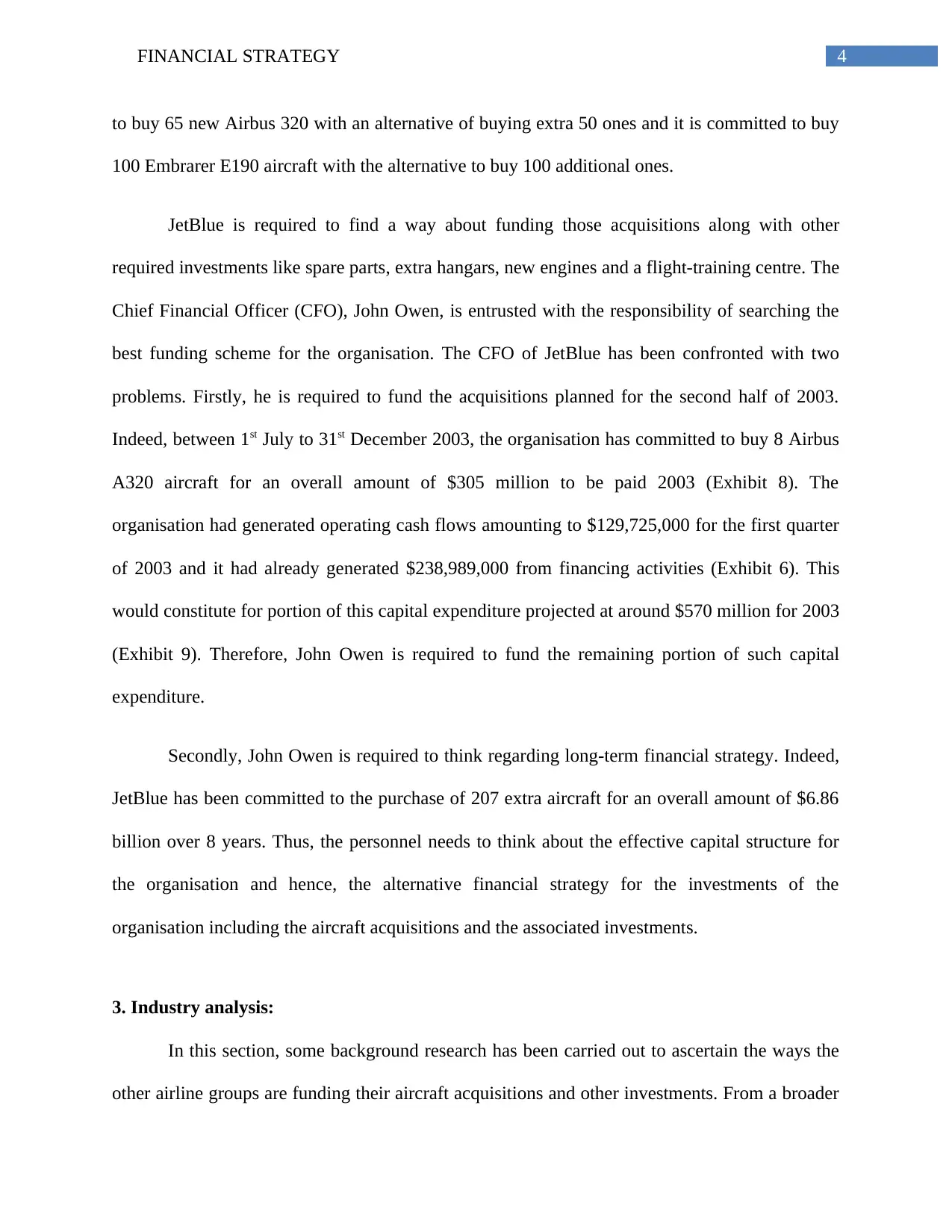
4FINANCIAL STRATEGY
to buy 65 new Airbus 320 with an alternative of buying extra 50 ones and it is committed to buy
100 Embrarer E190 aircraft with the alternative to buy 100 additional ones.
JetBlue is required to find a way about funding those acquisitions along with other
required investments like spare parts, extra hangars, new engines and a flight-training centre. The
Chief Financial Officer (CFO), John Owen, is entrusted with the responsibility of searching the
best funding scheme for the organisation. The CFO of JetBlue has been confronted with two
problems. Firstly, he is required to fund the acquisitions planned for the second half of 2003.
Indeed, between 1st July to 31st December 2003, the organisation has committed to buy 8 Airbus
A320 aircraft for an overall amount of $305 million to be paid 2003 (Exhibit 8). The
organisation had generated operating cash flows amounting to $129,725,000 for the first quarter
of 2003 and it had already generated $238,989,000 from financing activities (Exhibit 6). This
would constitute for portion of this capital expenditure projected at around $570 million for 2003
(Exhibit 9). Therefore, John Owen is required to fund the remaining portion of such capital
expenditure.
Secondly, John Owen is required to think regarding long-term financial strategy. Indeed,
JetBlue has been committed to the purchase of 207 extra aircraft for an overall amount of $6.86
billion over 8 years. Thus, the personnel needs to think about the effective capital structure for
the organisation and hence, the alternative financial strategy for the investments of the
organisation including the aircraft acquisitions and the associated investments.
3. Industry analysis:
In this section, some background research has been carried out to ascertain the ways the
other airline groups are funding their aircraft acquisitions and other investments. From a broader
to buy 65 new Airbus 320 with an alternative of buying extra 50 ones and it is committed to buy
100 Embrarer E190 aircraft with the alternative to buy 100 additional ones.
JetBlue is required to find a way about funding those acquisitions along with other
required investments like spare parts, extra hangars, new engines and a flight-training centre. The
Chief Financial Officer (CFO), John Owen, is entrusted with the responsibility of searching the
best funding scheme for the organisation. The CFO of JetBlue has been confronted with two
problems. Firstly, he is required to fund the acquisitions planned for the second half of 2003.
Indeed, between 1st July to 31st December 2003, the organisation has committed to buy 8 Airbus
A320 aircraft for an overall amount of $305 million to be paid 2003 (Exhibit 8). The
organisation had generated operating cash flows amounting to $129,725,000 for the first quarter
of 2003 and it had already generated $238,989,000 from financing activities (Exhibit 6). This
would constitute for portion of this capital expenditure projected at around $570 million for 2003
(Exhibit 9). Therefore, John Owen is required to fund the remaining portion of such capital
expenditure.
Secondly, John Owen is required to think regarding long-term financial strategy. Indeed,
JetBlue has been committed to the purchase of 207 extra aircraft for an overall amount of $6.86
billion over 8 years. Thus, the personnel needs to think about the effective capital structure for
the organisation and hence, the alternative financial strategy for the investments of the
organisation including the aircraft acquisitions and the associated investments.
3. Industry analysis:
In this section, some background research has been carried out to ascertain the ways the
other airline groups are funding their aircraft acquisitions and other investments. From a broader
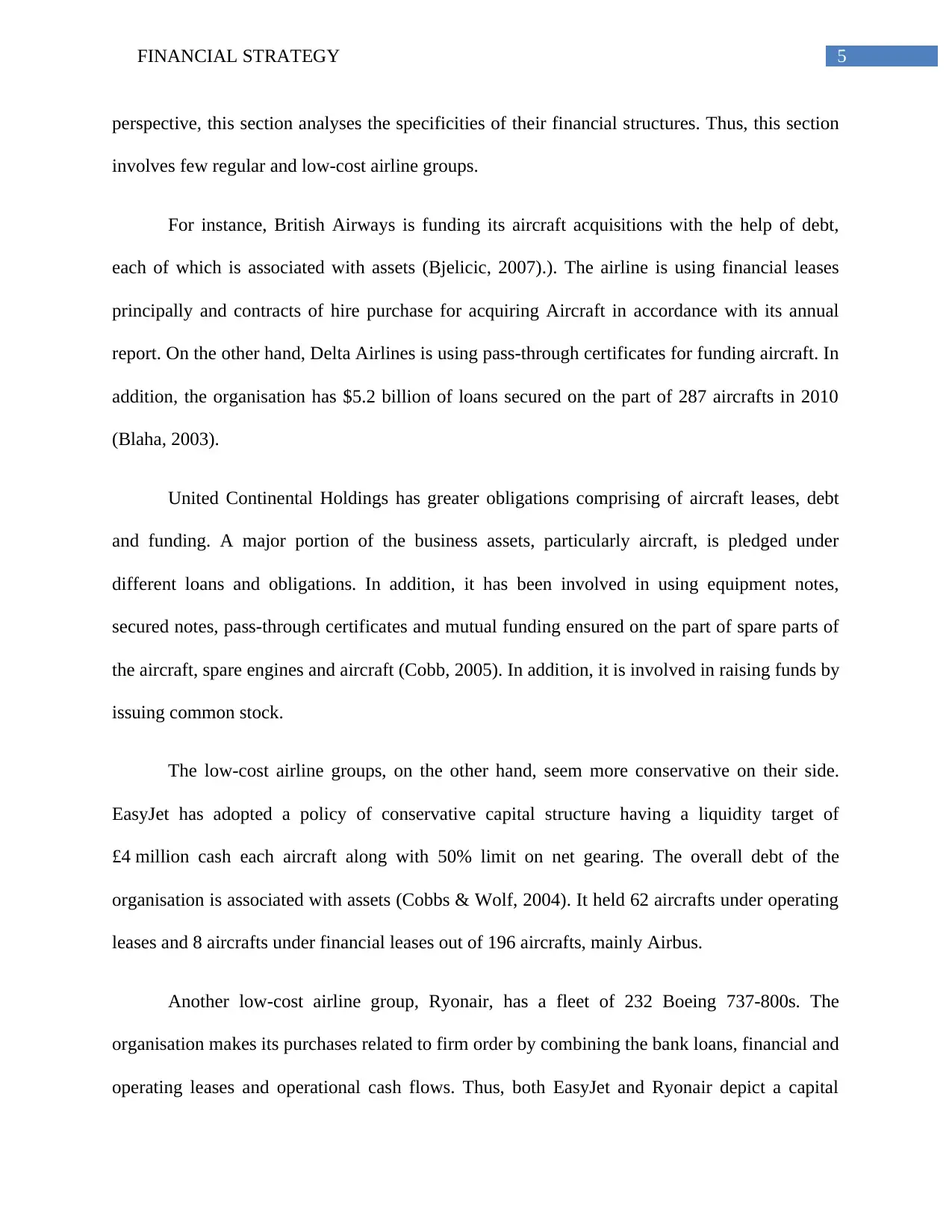
5FINANCIAL STRATEGY
perspective, this section analyses the specificities of their financial structures. Thus, this section
involves few regular and low-cost airline groups.
For instance, British Airways is funding its aircraft acquisitions with the help of debt,
each of which is associated with assets (Bjelicic, 2007).). The airline is using financial leases
principally and contracts of hire purchase for acquiring Aircraft in accordance with its annual
report. On the other hand, Delta Airlines is using pass-through certificates for funding aircraft. In
addition, the organisation has $5.2 billion of loans secured on the part of 287 aircrafts in 2010
(Blaha, 2003).
United Continental Holdings has greater obligations comprising of aircraft leases, debt
and funding. A major portion of the business assets, particularly aircraft, is pledged under
different loans and obligations. In addition, it has been involved in using equipment notes,
secured notes, pass-through certificates and mutual funding ensured on the part of spare parts of
the aircraft, spare engines and aircraft (Cobb, 2005). In addition, it is involved in raising funds by
issuing common stock.
The low-cost airline groups, on the other hand, seem more conservative on their side.
EasyJet has adopted a policy of conservative capital structure having a liquidity target of
£4 million cash each aircraft along with 50% limit on net gearing. The overall debt of the
organisation is associated with assets (Cobbs & Wolf, 2004). It held 62 aircrafts under operating
leases and 8 aircrafts under financial leases out of 196 aircrafts, mainly Airbus.
Another low-cost airline group, Ryonair, has a fleet of 232 Boeing 737-800s. The
organisation makes its purchases related to firm order by combining the bank loans, financial and
operating leases and operational cash flows. Thus, both EasyJet and Ryonair depict a capital
perspective, this section analyses the specificities of their financial structures. Thus, this section
involves few regular and low-cost airline groups.
For instance, British Airways is funding its aircraft acquisitions with the help of debt,
each of which is associated with assets (Bjelicic, 2007).). The airline is using financial leases
principally and contracts of hire purchase for acquiring Aircraft in accordance with its annual
report. On the other hand, Delta Airlines is using pass-through certificates for funding aircraft. In
addition, the organisation has $5.2 billion of loans secured on the part of 287 aircrafts in 2010
(Blaha, 2003).
United Continental Holdings has greater obligations comprising of aircraft leases, debt
and funding. A major portion of the business assets, particularly aircraft, is pledged under
different loans and obligations. In addition, it has been involved in using equipment notes,
secured notes, pass-through certificates and mutual funding ensured on the part of spare parts of
the aircraft, spare engines and aircraft (Cobb, 2005). In addition, it is involved in raising funds by
issuing common stock.
The low-cost airline groups, on the other hand, seem more conservative on their side.
EasyJet has adopted a policy of conservative capital structure having a liquidity target of
£4 million cash each aircraft along with 50% limit on net gearing. The overall debt of the
organisation is associated with assets (Cobbs & Wolf, 2004). It held 62 aircrafts under operating
leases and 8 aircrafts under financial leases out of 196 aircrafts, mainly Airbus.
Another low-cost airline group, Ryonair, has a fleet of 232 Boeing 737-800s. The
organisation makes its purchases related to firm order by combining the bank loans, financial and
operating leases and operational cash flows. Thus, both EasyJet and Ryonair depict a capital
⊘ This is a preview!⊘
Do you want full access?
Subscribe today to unlock all pages.

Trusted by 1+ million students worldwide

6FINANCIAL STRATEGY
structure, which depend less on debt in contrast to the counterparts of the regular firms. This is
illustrated with the help of the following table:
Particulars
British
Airways
Delta
Airlines
United Continental
Holdings EasyJet Ryonair
Long-term debt
3,698.0
0
13,179.0
0
11,434.0
0
1,084.6
0
2,690.7
0
Short-term debt
811.0
0
2,073.0
0
2,411.0
0
127.4
0
265.5
0
Equity
1,494.0
0
897.0
0
1,727.0
0
1,500.7
0
2,848.6
0
Capital
structure:
Debt/ Debt+
Equity 75.11% 94.45% 88.91% 44.68% 50.93%
Equity/Debt +
Equity 24.89% 5.55% 11.09% 55.32% 49.07%
Table 1: Capital structure of the global airline firms in 2007
(Source: Lee & Jang, 2007)
It is noteworthy that few small airline firms select to issue bonds for their overall
investments. Spicejet, an Indian airline firm, issued foreign currency convertible bonds in 2005
worth $90 million in financing aircraft acquisitions (Flouris & Oswald, 2006). Thus, all the
structure, which depend less on debt in contrast to the counterparts of the regular firms. This is
illustrated with the help of the following table:
Particulars
British
Airways
Delta
Airlines
United Continental
Holdings EasyJet Ryonair
Long-term debt
3,698.0
0
13,179.0
0
11,434.0
0
1,084.6
0
2,690.7
0
Short-term debt
811.0
0
2,073.0
0
2,411.0
0
127.4
0
265.5
0
Equity
1,494.0
0
897.0
0
1,727.0
0
1,500.7
0
2,848.6
0
Capital
structure:
Debt/ Debt+
Equity 75.11% 94.45% 88.91% 44.68% 50.93%
Equity/Debt +
Equity 24.89% 5.55% 11.09% 55.32% 49.07%
Table 1: Capital structure of the global airline firms in 2007
(Source: Lee & Jang, 2007)
It is noteworthy that few small airline firms select to issue bonds for their overall
investments. Spicejet, an Indian airline firm, issued foreign currency convertible bonds in 2005
worth $90 million in financing aircraft acquisitions (Flouris & Oswald, 2006). Thus, all the
Paraphrase This Document
Need a fresh take? Get an instant paraphrase of this document with our AI Paraphraser

7FINANCIAL STRATEGY
global airline groups are using debt, equity and operating cash flows to raise funds. For instance,
Air-France KLM, Lufthansa, Air Canada, British Airways, Avianca, Australia’s Virgin Blue and
Kingfisher issued bonds in 2009. AMR, on the other hand, used private lenders for borrowing
money. From this study, it has been found out that most of the airlines are funding their aircraft
acquisitions except from using operational cash flows. This either is primarily through debt
secured debt or leases. The other investment requirements are funded through either equity or
debt based on the organisations. However, an inherent trend to low-cost firms appears to be their
conservative financial structures in contrast to larger and regular airline firms.
4. Financial alternatives:
For funding the acquisitions for the leftover part of 2003, JetBlue received two financial
alternatives from the investment banks. The first option is to raise additional 2.6 million shares at
a projected rate of $42.50 per share. JetBlue would be able to fund up to $110.5 million. The
bank fees and commissions for this proposal amount to $3,591,250 and they depict a cost of
3.25%. The second option from the investment banks is to $150 million in a private placement
pertaining to convertible debentures. The debentures would be a convertible debt of 30-year
having a coupon rate of 3.5%. Moreover, the debt would be convertible into JetBlue’s shares at
$63.75 per share and it depicts a conversion rate of 15.6863 shares per $1,000 principal note
amount (Flouris & Walker, 2005). These notes would be unsecured obligations and these would
rank identical in payment right with other unsecured debt. At present, all the debts of JetBlue are
secured. In addition, the airline does not have to incur any additional fees for this option.
There are some other alternatives available for JetBlue as well. Indeed, the organisation
could issue few preferred stocks. Such stocks might be taken into account in the form of equity
global airline groups are using debt, equity and operating cash flows to raise funds. For instance,
Air-France KLM, Lufthansa, Air Canada, British Airways, Avianca, Australia’s Virgin Blue and
Kingfisher issued bonds in 2009. AMR, on the other hand, used private lenders for borrowing
money. From this study, it has been found out that most of the airlines are funding their aircraft
acquisitions except from using operational cash flows. This either is primarily through debt
secured debt or leases. The other investment requirements are funded through either equity or
debt based on the organisations. However, an inherent trend to low-cost firms appears to be their
conservative financial structures in contrast to larger and regular airline firms.
4. Financial alternatives:
For funding the acquisitions for the leftover part of 2003, JetBlue received two financial
alternatives from the investment banks. The first option is to raise additional 2.6 million shares at
a projected rate of $42.50 per share. JetBlue would be able to fund up to $110.5 million. The
bank fees and commissions for this proposal amount to $3,591,250 and they depict a cost of
3.25%. The second option from the investment banks is to $150 million in a private placement
pertaining to convertible debentures. The debentures would be a convertible debt of 30-year
having a coupon rate of 3.5%. Moreover, the debt would be convertible into JetBlue’s shares at
$63.75 per share and it depicts a conversion rate of 15.6863 shares per $1,000 principal note
amount (Flouris & Walker, 2005). These notes would be unsecured obligations and these would
rank identical in payment right with other unsecured debt. At present, all the debts of JetBlue are
secured. In addition, the airline does not have to incur any additional fees for this option.
There are some other alternatives available for JetBlue as well. Indeed, the organisation
could issue few preferred stocks. Such stocks might be taken into account in the form of equity
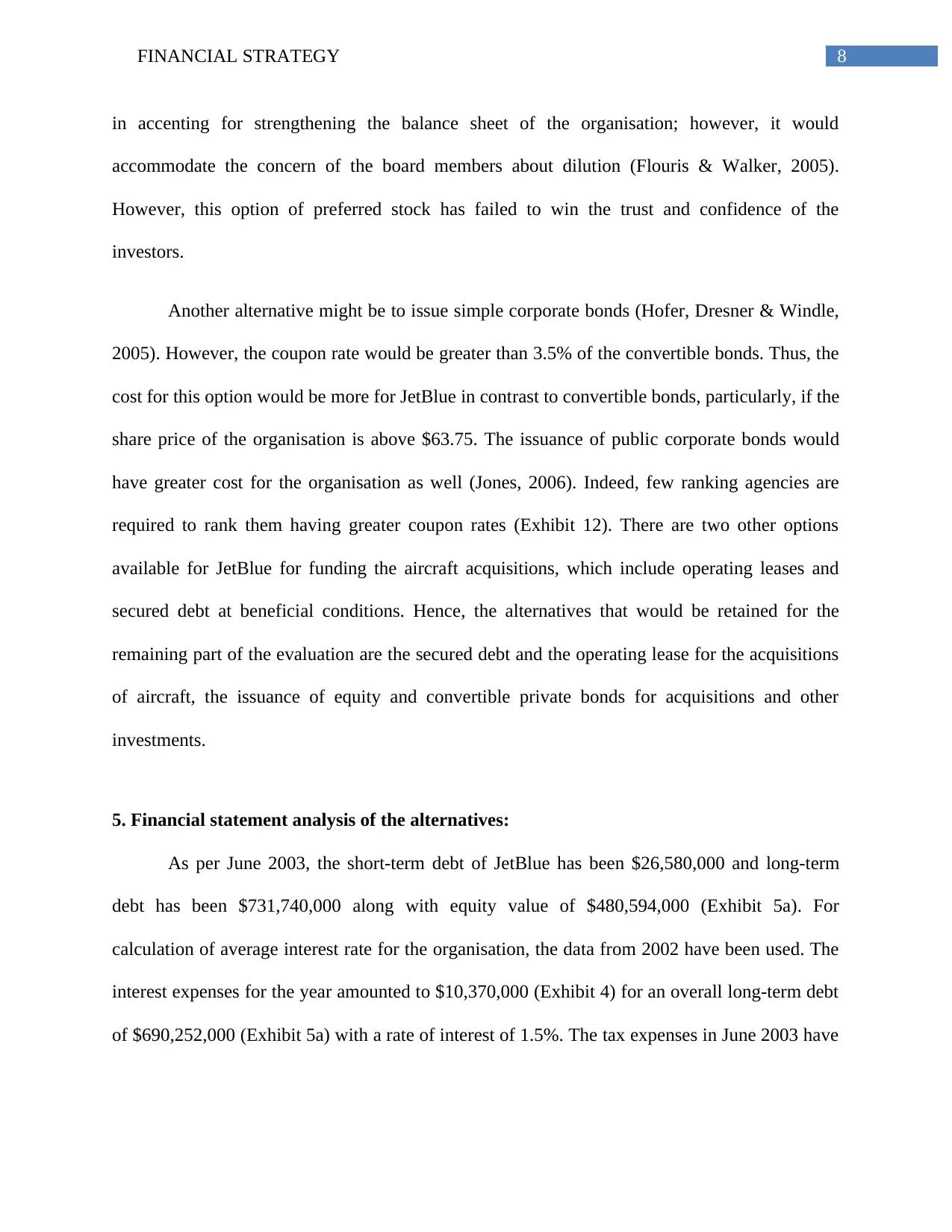
8FINANCIAL STRATEGY
in accenting for strengthening the balance sheet of the organisation; however, it would
accommodate the concern of the board members about dilution (Flouris & Walker, 2005).
However, this option of preferred stock has failed to win the trust and confidence of the
investors.
Another alternative might be to issue simple corporate bonds (Hofer, Dresner & Windle,
2005). However, the coupon rate would be greater than 3.5% of the convertible bonds. Thus, the
cost for this option would be more for JetBlue in contrast to convertible bonds, particularly, if the
share price of the organisation is above $63.75. The issuance of public corporate bonds would
have greater cost for the organisation as well (Jones, 2006). Indeed, few ranking agencies are
required to rank them having greater coupon rates (Exhibit 12). There are two other options
available for JetBlue for funding the aircraft acquisitions, which include operating leases and
secured debt at beneficial conditions. Hence, the alternatives that would be retained for the
remaining part of the evaluation are the secured debt and the operating lease for the acquisitions
of aircraft, the issuance of equity and convertible private bonds for acquisitions and other
investments.
5. Financial statement analysis of the alternatives:
As per June 2003, the short-term debt of JetBlue has been $26,580,000 and long-term
debt has been $731,740,000 along with equity value of $480,594,000 (Exhibit 5a). For
calculation of average interest rate for the organisation, the data from 2002 have been used. The
interest expenses for the year amounted to $10,370,000 (Exhibit 4) for an overall long-term debt
of $690,252,000 (Exhibit 5a) with a rate of interest of 1.5%. The tax expenses in June 2003 have
in accenting for strengthening the balance sheet of the organisation; however, it would
accommodate the concern of the board members about dilution (Flouris & Walker, 2005).
However, this option of preferred stock has failed to win the trust and confidence of the
investors.
Another alternative might be to issue simple corporate bonds (Hofer, Dresner & Windle,
2005). However, the coupon rate would be greater than 3.5% of the convertible bonds. Thus, the
cost for this option would be more for JetBlue in contrast to convertible bonds, particularly, if the
share price of the organisation is above $63.75. The issuance of public corporate bonds would
have greater cost for the organisation as well (Jones, 2006). Indeed, few ranking agencies are
required to rank them having greater coupon rates (Exhibit 12). There are two other options
available for JetBlue for funding the aircraft acquisitions, which include operating leases and
secured debt at beneficial conditions. Hence, the alternatives that would be retained for the
remaining part of the evaluation are the secured debt and the operating lease for the acquisitions
of aircraft, the issuance of equity and convertible private bonds for acquisitions and other
investments.
5. Financial statement analysis of the alternatives:
As per June 2003, the short-term debt of JetBlue has been $26,580,000 and long-term
debt has been $731,740,000 along with equity value of $480,594,000 (Exhibit 5a). For
calculation of average interest rate for the organisation, the data from 2002 have been used. The
interest expenses for the year amounted to $10,370,000 (Exhibit 4) for an overall long-term debt
of $690,252,000 (Exhibit 5a) with a rate of interest of 1.5%. The tax expenses in June 2003 have
⊘ This is a preview!⊘
Do you want full access?
Subscribe today to unlock all pages.

Trusted by 1+ million students worldwide

9FINANCIAL STRATEGY
been $40,188,000 for overall earnings before tax of $95,503,000 (Exhibit 4) with a corporate tax
rate of 42% (Kochan, 2006).
According to Exhibit 1, the equity beta of JetBlue from April 2002 to June 2003 has been
0.69. In addition as per Exhibit 5a for June 2003, the financial structure of the organisation has
been represented as follows:
Particulars Amount (in $)
Long-term debt 731,740
Short-term debt 26,580
Equity 480,594
Capital structure:
Debt/Debt + Equity 61.21%
Equity/Debt + Equity 38.79%
Table 2: Capital structure of Jet Airways in 2003
(Source: Lynch & Barger, 2006)
In accordance with the formula of Hamada, the unlevered beta for JetBlue has been
calculated as follows:
Beta (u) = Beta (I)/ [1+(1-T)*(Wd/ We)
Beta (I) = 0.69, T = 0.42, Wd = 61.21 and We = 38.79
Beta (u) = 0.36
been $40,188,000 for overall earnings before tax of $95,503,000 (Exhibit 4) with a corporate tax
rate of 42% (Kochan, 2006).
According to Exhibit 1, the equity beta of JetBlue from April 2002 to June 2003 has been
0.69. In addition as per Exhibit 5a for June 2003, the financial structure of the organisation has
been represented as follows:
Particulars Amount (in $)
Long-term debt 731,740
Short-term debt 26,580
Equity 480,594
Capital structure:
Debt/Debt + Equity 61.21%
Equity/Debt + Equity 38.79%
Table 2: Capital structure of Jet Airways in 2003
(Source: Lynch & Barger, 2006)
In accordance with the formula of Hamada, the unlevered beta for JetBlue has been
calculated as follows:
Beta (u) = Beta (I)/ [1+(1-T)*(Wd/ We)
Beta (I) = 0.69, T = 0.42, Wd = 61.21 and We = 38.79
Beta (u) = 0.36
Paraphrase This Document
Need a fresh take? Get an instant paraphrase of this document with our AI Paraphraser
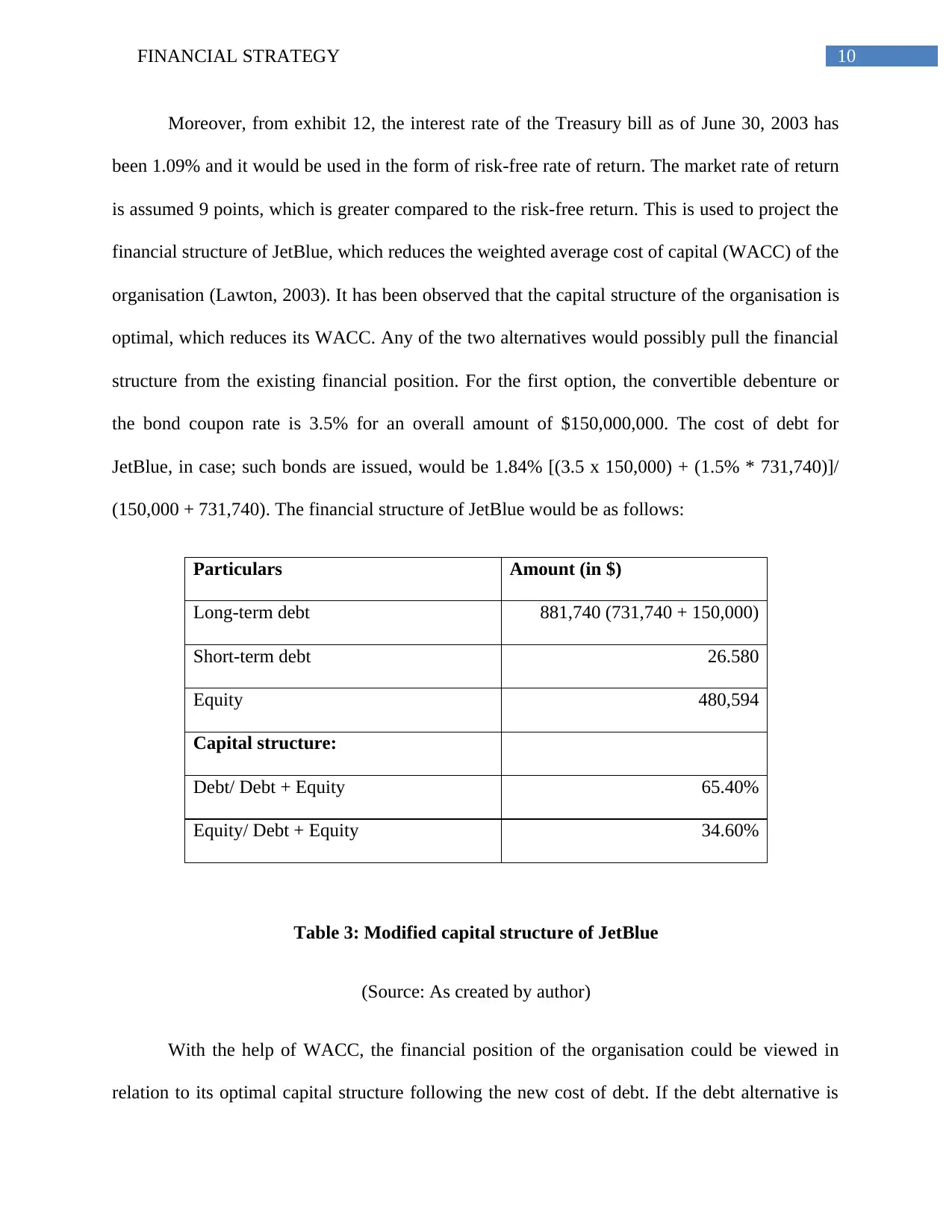
10FINANCIAL STRATEGY
Moreover, from exhibit 12, the interest rate of the Treasury bill as of June 30, 2003 has
been 1.09% and it would be used in the form of risk-free rate of return. The market rate of return
is assumed 9 points, which is greater compared to the risk-free return. This is used to project the
financial structure of JetBlue, which reduces the weighted average cost of capital (WACC) of the
organisation (Lawton, 2003). It has been observed that the capital structure of the organisation is
optimal, which reduces its WACC. Any of the two alternatives would possibly pull the financial
structure from the existing financial position. For the first option, the convertible debenture or
the bond coupon rate is 3.5% for an overall amount of $150,000,000. The cost of debt for
JetBlue, in case; such bonds are issued, would be 1.84% [(3.5 x 150,000) + (1.5% * 731,740)]/
(150,000 + 731,740). The financial structure of JetBlue would be as follows:
Particulars Amount (in $)
Long-term debt 881,740 (731,740 + 150,000)
Short-term debt 26.580
Equity 480,594
Capital structure:
Debt/ Debt + Equity 65.40%
Equity/ Debt + Equity 34.60%
Table 3: Modified capital structure of JetBlue
(Source: As created by author)
With the help of WACC, the financial position of the organisation could be viewed in
relation to its optimal capital structure following the new cost of debt. If the debt alternative is
Moreover, from exhibit 12, the interest rate of the Treasury bill as of June 30, 2003 has
been 1.09% and it would be used in the form of risk-free rate of return. The market rate of return
is assumed 9 points, which is greater compared to the risk-free return. This is used to project the
financial structure of JetBlue, which reduces the weighted average cost of capital (WACC) of the
organisation (Lawton, 2003). It has been observed that the capital structure of the organisation is
optimal, which reduces its WACC. Any of the two alternatives would possibly pull the financial
structure from the existing financial position. For the first option, the convertible debenture or
the bond coupon rate is 3.5% for an overall amount of $150,000,000. The cost of debt for
JetBlue, in case; such bonds are issued, would be 1.84% [(3.5 x 150,000) + (1.5% * 731,740)]/
(150,000 + 731,740). The financial structure of JetBlue would be as follows:
Particulars Amount (in $)
Long-term debt 881,740 (731,740 + 150,000)
Short-term debt 26.580
Equity 480,594
Capital structure:
Debt/ Debt + Equity 65.40%
Equity/ Debt + Equity 34.60%
Table 3: Modified capital structure of JetBlue
(Source: As created by author)
With the help of WACC, the financial position of the organisation could be viewed in
relation to its optimal capital structure following the new cost of debt. If the debt alternative is
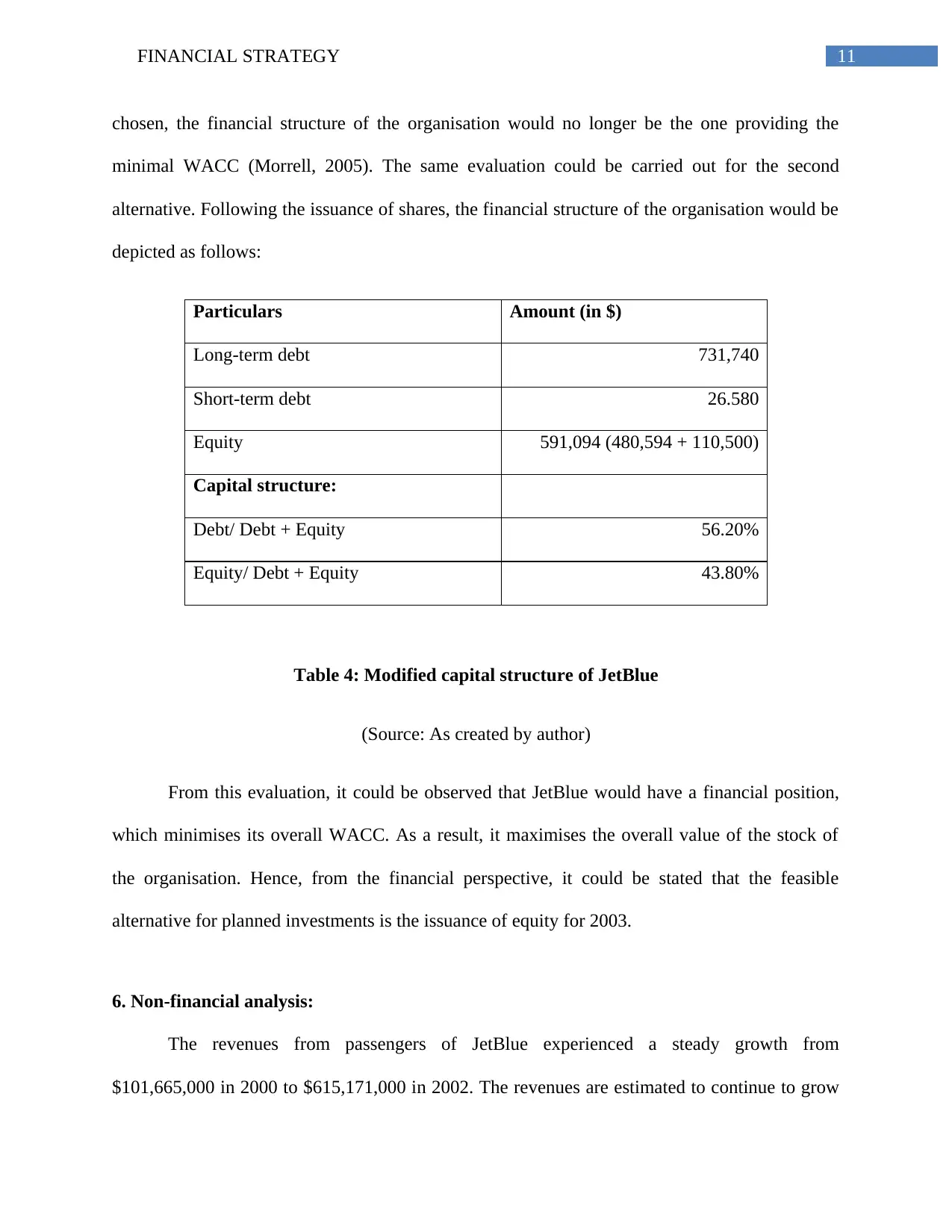
11FINANCIAL STRATEGY
chosen, the financial structure of the organisation would no longer be the one providing the
minimal WACC (Morrell, 2005). The same evaluation could be carried out for the second
alternative. Following the issuance of shares, the financial structure of the organisation would be
depicted as follows:
Particulars Amount (in $)
Long-term debt 731,740
Short-term debt 26.580
Equity 591,094 (480,594 + 110,500)
Capital structure:
Debt/ Debt + Equity 56.20%
Equity/ Debt + Equity 43.80%
Table 4: Modified capital structure of JetBlue
(Source: As created by author)
From this evaluation, it could be observed that JetBlue would have a financial position,
which minimises its overall WACC. As a result, it maximises the overall value of the stock of
the organisation. Hence, from the financial perspective, it could be stated that the feasible
alternative for planned investments is the issuance of equity for 2003.
6. Non-financial analysis:
The revenues from passengers of JetBlue experienced a steady growth from
$101,665,000 in 2000 to $615,171,000 in 2002. The revenues are estimated to continue to grow
chosen, the financial structure of the organisation would no longer be the one providing the
minimal WACC (Morrell, 2005). The same evaluation could be carried out for the second
alternative. Following the issuance of shares, the financial structure of the organisation would be
depicted as follows:
Particulars Amount (in $)
Long-term debt 731,740
Short-term debt 26.580
Equity 591,094 (480,594 + 110,500)
Capital structure:
Debt/ Debt + Equity 56.20%
Equity/ Debt + Equity 43.80%
Table 4: Modified capital structure of JetBlue
(Source: As created by author)
From this evaluation, it could be observed that JetBlue would have a financial position,
which minimises its overall WACC. As a result, it maximises the overall value of the stock of
the organisation. Hence, from the financial perspective, it could be stated that the feasible
alternative for planned investments is the issuance of equity for 2003.
6. Non-financial analysis:
The revenues from passengers of JetBlue experienced a steady growth from
$101,665,000 in 2000 to $615,171,000 in 2002. The revenues are estimated to continue to grow
⊘ This is a preview!⊘
Do you want full access?
Subscribe today to unlock all pages.

Trusted by 1+ million students worldwide
1 out of 18
Related Documents
Your All-in-One AI-Powered Toolkit for Academic Success.
+13062052269
info@desklib.com
Available 24*7 on WhatsApp / Email
![[object Object]](/_next/static/media/star-bottom.7253800d.svg)
Unlock your academic potential
Copyright © 2020–2025 A2Z Services. All Rights Reserved. Developed and managed by ZUCOL.





